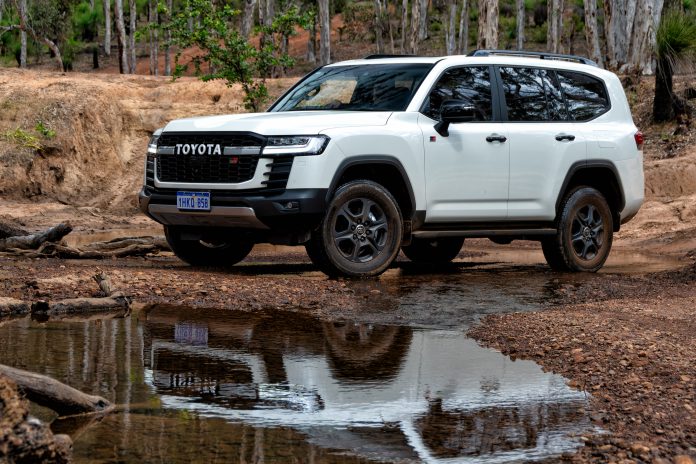With an almost fanatical following, the 200 series Landcruiser has finally reached the end of its reign as King of the Mountain. After 14-years of being the acknowledged go anywhere do anything, comfortable, robust, and reliable family adventure wagon, it’s no surprise that there’s a tornado of speculation over just how good, or bad, the all-new 300 series will prove to be.
Toyota know well the Landcruiser’s standing in the Australian 4WD community and understand the criticality of not compromising the Landcruiser’s proven quality, reliability and durability if it wants to maintain a loyal following.
So important was this all-new replacement that design and development began here in Oz back in 2014, where Toyota recognises the experience and skills of local engineering teams as a centre of excellence. Australia was the first destination for Toyota’s five continents drive, as Australia has 80% of the conditions experienced across the world for on and off-road driving challenges, especially in dusty, hot, and demanding conditions. No less than six prototype vehicles, the most ever deployed by Japan, were pushed and punished to the point of failure in desert regions of central Australia, the Victorian high country, and the tropics with additional testing at the AARC testing facility in Anglesea.
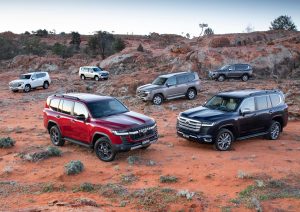
There are six models in the line-up, with the first five variants following a consistent design theme separated by subtle aesthetic variations across wheel dressings and trim details. The no frills base GX $89,990 is ready to get down and dirty for a hard day’s work. It’s a clean sheet, likely to be more accepting of aftermarket modifications and accessories, designed to give an owner more freedom to customise their vehicle setup, plus it has the greatest payload capacity at a respectable 785kg.
If you hanker for more self-indulgence, scroll up the GXL ($101,790), the VX ($113,990, or Sahara ($131,990) which progressively offer more features, comfort and convenience, equipment specs and enhanced styling. The range topping Sahara ZX ($138,790) is the consummate double whipped cream luxury town car, unashamedly directed at the buyer with less frequent desire for remote locations, and who values street appeal, passenger comfort and luxury appointments such as rear seat movies on demand. A buyer who enjoys the level of confidence and control this type of vehicle provides, to ensure no matter how challenging the gravel road to the winery, their opulently appointed chariot is not only capable of carrying a case or six of Henschke Hill of Grace Shiraz but will provides supreme comfort and good looks for the luxury off-road experience.
We’re focusing on the sixth member of the clan, the $137,790 GR Sport. This tough kid on the block stands out from the rest of the gang, with a purposeful stance to signify individuality. Kind of like Sporty Spice, who was a little left of field from her dolled-up girly-friends.
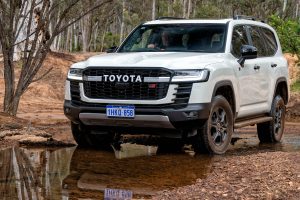
It’s bold black honeycomb grille, with large white Toyota lettering, harks back to an earlier time in Landcruiser history. It’s framed by strong horizontal bars that merge seamlessly into sharp daytime running lights, accentuating the new slim line Projector Bi-LED headlamps, that harmonise with the restyled tail lamps and rear LED sequential turn signals. Blacked-out window surrounds, door handles, exterior mirrors, and roof rails, with wheel arches and mudguard mouldings that highlight the now vertical cut fenders along with the lower rear hatch edge receiving the same treatment to complete the GR’s tough-toy ready for action appearance.
Perhaps the design team only remembered the wheels ten minutes left before knock-off on Friday afternoon ahead of a long weekend. The prosaic 18-inch matte black alloy rims, wrapped in 265/65R18 rubber, do dis-service to the GR’s otherwise rugged outward muscular good looks. More worrying was the patchy paint finish on the rims. Let’s hope it was due to the constant succession of strong commercial cleaning products used after each media onslaught.
Interestingly, in a similar design we saw on the Discovery 3, the rear door seam doesn’t finish forward of the wheel arch. Instead, it forms part of the wheel arch, wrapping round into the wheel well. This smart design leaves a clean inner archway when the vehicle is covered in mud to keep passengers clean when entering or exiting the rear.
Standing in front of the new 300 LC, my first impression was, “Hallelujah, common sense has prevailed”, The Australian and Japanese engineering and design teams resisted the annoying American trend of super sizing. The outward dimensions of the new 300 are only marginally different to those of its predecessor which is a good thing if manoeuvring in heavy traffic, negotiating multi-storey carparks, navigating busy school pick up zones, or squeezing through tight bush tracks is important to you. Anything bigger as a family daily driver in suburbia, and your neighbours might wonder if you’re overcompensating for something else.
Round back, there’s an integrated hitch receiver neatly concealed behind a bumper trim cover and built into the rear cross member, providing improved towing stability while retaining 3,500kg braked towing capacity. Trailer wiring is now part of the factory harness on every model, making trailer hook up a breeze.
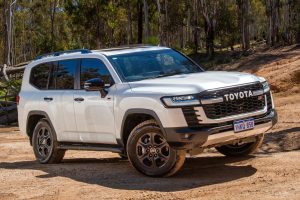
It’s worth noting that the new LC300 is still body-on-frame, utilising Toyota’s evolving TNGA modular platform-sharing architecture. For the LC300, there’s a 20% improvement in structural rigidity over the previous 200 series through larger cross-members and super-high tensile steel. The body is also stronger thanks to additional adhesive joins on seams throughout the body and introducing advanced laser blank welding techniques. Depending on the model variant, Toyota achieved weight savings of up to 160kg by using aluminium panels for the roof, side and rear doors and bonnet.
For example, the Sahara 200 turbo diesel’s kerb weight was 2,740kg and our slimmer GR Sport tipped the scales at 2,630kg, some 110kg lighter. Before you gleefully commit that weight saving to extra cargo capacity, note that the GVM figures have also dropped. The 200 was rated at 3,350kg; the GR Sport is only 3,280kg meaning your cargo payload is improved by 70kg.
Apart from the facelifted front end, the big change to the status quo is the one-piece tailgate door. New to brand purchasers will accept the modern SUV styled rear access with simple one piece operation, better dust sealing thanks to a singular door seal and the absence of needing to lean over to reach stowed items from the rear cargo space. Traditionalists will grumble at the lack of the impromptu table to make a cuppa, or as a comfortable seat to enjoy said cuppa with a slice of tea cake. Not to mention the fact it was a solid, sturdy platform providing excellent access to the roof rack for camping gear.
Most of us are reluctant to accept change; think of the reaction when Toyota dropped the live axle front end. But now we’re all enjoying the greater stability and improved on-road handling with plenty of Independent Front Suspension (IFS) LCs confidently conquering the outback.
The GR’s unembellished exterior belies the luxuriously appointed interior and serious off-road arsenal buried beneath its outer skin.
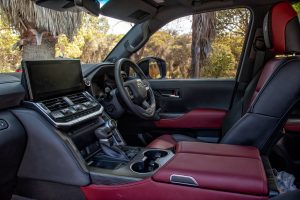
Inside, our GR Sport was wearing the very fetching red and black colour scheme of Ryan Reynolds alter ego Deadpool. I really liked that you now feel like you’re sitting in the LC300, as opposed to riding on it. The console and modern gear lever rise up to meet the driver cocooned in their own cockpit. If you initially feel it’s too enclosed; drive it for a day or two and you’ll appreciate the well thought out ergonomics with driver-dedicated focus and design.
Looking around the cabin, there’s an effective cooler box at the rear of the console with a clever left, right and rear opening lid to provide easy access for cool drinks and treats. Soft touch materials cover all human contact points to protect, elbows, knees, arms, and hands. Finally, someone gets it! You’ll love large cup holders with removable stepped bases to accommodate both small and large coffee orders, door pockets will hold 750ml water bottles and there’s a convenient wireless phone charging base to the left of the gear leaver. On the right, within easy reach, are push button controls to activate the centre locking differential, Toyota’s kick a…s turn assist, brake hold function (even less desirable than auto stop start) and a new electric park brake.
Yep, I developed a facial tic thinking about dust, dirt, mud and moisture—what could go wrong?
More credit to the designer. There’s a prominent metal toggle switch for high and low transfer case operation that you can even locate in the dark… nice one! What’s this…? A slot for CDs. I couldn’t decide if it was retro-nostalgic, catering to old-school afficionados or just outdated in a modern interior.
The driver’s side console pillar houses a large multi-select rotary dial that changes settings for both vehicle drive modes and off-road multi-terrain options pending on which system you’ve activated via the buttons. Adorning the upper console is an impressive 12.3-inch electronic multi vision (T-EMV) split touchscreen that can swap the display information left to right, allowing the passenger to control various functions. It provides quick and easy access to AC and heating settings, GPS and audio with integration for Android Auto and Apple car play, blue tooth connectivity, voice commands. The absence of wireless connectivity in a vehicle of this calibre seems an oversight. The centre screen is directly integrated with the 7-inch driver multi-information display tucked between classic old style analogue tacho and speedometer, allowing you to toggle through vehicle information and system settings.
Below the main screen are large button controls for heating or cooling the very comfortable 8-way power adjustable driver and passenger leather covered front seats with three position recall on the driver’s side. You’ll also appreciate the additional manual controls for AC settings, demisters, and heated steering wheel easily operable even when wearing gloves in colder weather. There’s a stylish array of satin metal buttons outlining the control panel that enables shortcut access to various functions rather than navigating menu options on the touch screen.
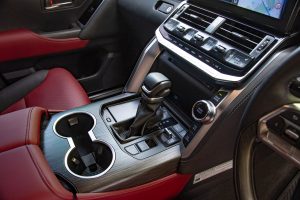
Toyota say the designers also prioritised functionality, with all dashboard switches grouped according to their driving, audio, and climate functions. For the most part, I’d agree. However, the front and rear locking differential switches, handy idle up, and DPF operation were logically grouped together but mounted underneath the camera and trip switches in a hard-to-reach position on the lower dash fascia obscured by your left knee cap or steering wheel depending on the angle of the vehicle in challenging off-road terrain, which is when you’re likely to want to access them easily and quickly.
Why not place them conveniently on the opposing console pillar with a caveat control, such as activating the centre diff lock or selecting an MTS mode, to enable operation so they can’t accidentally be engaged. Leaning over and fumbling for the ON button with the vehicle perched in a precarious position is not ideal.
If you’re like me and appreciate listening to your favourite artists to while away long tedious hours on the black top, a good audio system is more than a convenient accessory. It’s a regularly used key vehicle feature, and I expect a quality of sound commensurate with the vehicle’s price point. The 14-speaker JBL premium audio system does a reasonable job mixing up the melodies.
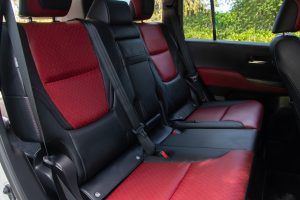
Open the rear door, pull yourself in via one of the multiple solid grab handles throughout the cabin, and it’s a rather comfy place to plonk. Recline the back rest and soak up picturesque bush surroundings whilst you charge up your phone or camera via the USB and 12v ports. You’re well catered for with your own AC controls, plus you also get the typically limited to up-front heated and ventilated leather seats, very cool. Taller rear passengers will instantly appreciate the impressive extra 92mm of leg room on offer thanks to the more rearward seating location.
The GR Sport is a standard 5-seater—only the GXL VX and Sahara variants offer a seven-seat option. If you’re not hoicking around family or friends, the second row effortlessly tumbles forward in a 40:20:40 configuration to increase your rear cargo space from an ample 1,131 litres to a humongous 2,052 litres. I was disappointed to see there was only a single 220V GPO in the back and no 12V socket for the convenience of hooking up a 12v car fridge. Call me old school, but I prefer 12V for camping. I’m happy to use an inverter for GPO household voltages in the camper or caravan to power microwaves or ovens or plug in the battery charger when staying in a caravan park. But hey, each to their own.
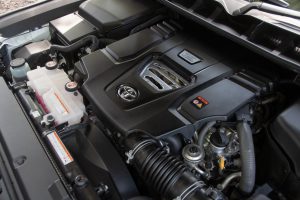
Tap the start button, and those hard core V8 fan boys are going to miss that soft baritone rumble and smoothness of the old bent eight. This new high tech hot V 90-degree V6 has some big shoes to fill. Don’t get caught up in the misleading speculation that it’s nothing more than a cut down variant of the old rattler. Sure, it has the same bore and stroke as the big grumbler, so cylinder displacement is the same; but Toyota most likely kept the commonly used bore-to-stroke ratio because it provides a good balance of power as rpm builds. thanks to the relatively flat torque curve and efficiency.
It’s not so much that the V6 is copying the V8, rather that the engineers are leveraging a well-known configuration that will enhance their efforts to achieve the driving characteristics and performance capability expected by current V8 Landcruiser owners.
Reversing the direction of flow and having the exhaust and turbos placed inside the V of the motor is also nothing new. Its origins can be traced back to Formula One racing in the early eighties. There’s significant benefit in minimising exhaust gas temperature loss and reducing turbo efficiency. The added heat energy helps improve performance and response whilst the close proximity ensures the highest exhaust flow rates. Why else would have BMW, Porsche, AMG and Audi applied the same principles?
Improvements in low engine rpm for power and torque delivery are further enhanced through the use of dual variable vane turbos enabling control over the rate and amount of boost, resulting in a more linear delivery of power rather than an abrupt surge. Unlike the 200’s turbos working in parallel with one turbo looking after one bank, the 300 utilises the primary turbocharger for low end response then engages the second turbo above 2,600rpm to extend boots across a broad rpm range and achieve good power delivery regardless of slow off-roading, fast highway cruising or pulling a load.
Unlike most V6 setups, which typically have a 60-degree angle as the optimal configuration for engine balance, Toyota has used a 90-degree V to squeeze in everything and it’s still a tight fit under the heavily heat-shielded turtle shell engine cover. 90-degree V6s are more prone to vibration—which is why Toyota has utilised balance shafts and hydraulic engine mounts to counteract the impact. Other internal improvements reduce friction and improve strength, whilst trying to reduce intrusive cabin noise with a quieter injection system.
Toyota claim 227kW at 4,000rpm (up 13.5%), and 700Nm available across the 1,600 to 2,600 rev range. This is an increase of 7.7% for peak torque. With fuel economy for the fire breathing V6 claimed at a frugal 8.9L/100, equating to an improvement of 6%. This all looks positive until you realise they have cut the fuel tank capacity by 28L down from 138L to 110L.
The theoretical range at stated fuel consumption for 9.5L/100 for the old 200 would give you around 1,400kms to a tank. The updated and more expensive 300 delivers a range of some 200kms less. Moving past the misdirection and distraction of marketing hype and the new 300 both giveth and taketh. Overall gains are subtle when balancing the factual cheque book considering both the pros and cons of high tech and complex engineering adaptations to what is essentially the same basic layout and design. Revolution by radical change? No, more a progressive evolution.
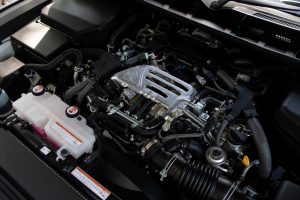
And I can’t forget a niggling concern—heat. A proven design in a high-performance road car may not translate perfectly to a large, heavy 4WD hauling a 3.5T caravan up a long and winding 15-degree incline on a 40°C day. Especially if you shut down with no air flow at the bowser while the tank gets filled and your other half strolls into the shop for snacks. Intense heat soak is an automotive component killer. Fact!
No, not scare mongering. It happens today with the V8 200 series—check it out on YouTube where you’ll see what happens when you add a roof rack, awning, bull bar, winch, dual batteries, long range tank, dual rear wheel carrier, rear drawers, fridge and slide, recovery gear, camping equipment, two-inch suspension lift, screaming kids and camper trailer in tow with over inflated 35 inch mud tyres. Then watch as the driver makes their fourth attempt to exit a boggy beach on a hot day nearly sending several of his pistons into orbit as the engine rpm bounces on the rev limiter, sounding more like a Group A touring car than a family tourer.
While most folk will keep a closer eye on the temp gauge and respond accordingly; at the very least, it will induce DPF regeneration at closer intervals given the increased levels of soot.
Hopefully loyal owners and Toyota warranty clerks can share a giggle over the next 14 years if the 300 proves as bullet proof and reliable as Toyota’s marketing division promise. Cause the latest generation of tech and internet savvy buyers may not be so willing to accept compromise and hold Toyota to their claims.
Around town in stop-start traffic, the 300 is comfortable with good outward visibility thanks to deep side windows, large wing mirrors and raised seating position. The intimidating external dimensions of the big cruiser don’t translate into adverse road manners or reduced driveability. There’s a clear improvement over the 200 while retaining a reassuring sense of protection with this much bulk surrounding you.
The character of the 300 is quite different from its predecessor. Gone is that heavy, docile steering response, and a front-end suspension that wants to lay down in corners because of the considerable weight hanging over the front axle. Much to the disappointment of aftermarket suppliers and installers offering suspension upgrades to fix this perennial fault; you might not need to upgrade the new 300, pending your intended use.
There was a who’s who list of driver assist systems bolted into our GR Sport, most standard on vehicles of this calibre to maintain a watchful eye on surroundings be it rear-cross traffic when reversing blindly out of a parking space, or vehicles sitting in your blind spot when needing to change lanes or helping to avoid distracted pedestrians texting on their phones as they step out in front of you. It’s subtle but valuable peace of mind, allowing you to relax that white knuckle grip on the wheel when piloting such a big vehicle.
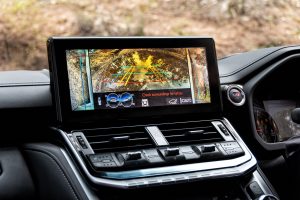
With all models in the 300 series line up having reverse cameras with trajectory lines, the 11.8m turning circle of our GR Sport and its multi-terrain monitor with panoramic view capability, generated a clear view of any obstacles or clearance issues around the vehicle via four external cameras. This makes manoeuvring in tight spaces less likely to have you breaking out in a cold sweat, despite the owner of the vehicle next to you learning parallel parking from the back of a cereal box.
Spend time in the GR Sport and you gain an appreciation for why the Landcruiser is so popular as a long-distance tourer and tow tug. Given its weight and dimensions, this is a vehicle that would feel confident in driving rain, heavy winds, dry heat, or dusty conditions.
On country roads, trundling along at 110km/h and scrolling through the various drive modes, I found comfort to be the best compromise on those long endless stretches as it soaks up most road irregularity and bumps with minimal disruption to the serenity of the cabin. Gliding along effortlessly, there’s minimal driver effort required other than following the intended direction of travel. Sport was preferable for crisper power delivery over undulating terrain and with a little more body control through sweeping bends. Eco and normal allow further customisation for driver preference to adjust the throttle curve, gear changes, or shock absorber response for ride performance.
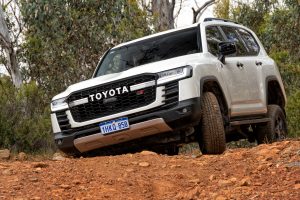
But let’s step up the pace a little and push the new cruiser a little harder. Cornering and vehicle stability are where the 300 widens the gap to the 200, and this can be directly attributed to the weight savings and lower Centre Of Gravity (COG) by moving the compact V6 engine further back and lower into the chassis. Getting the COG closer to the roll centres of the front and rear suspension has improved control over body pitch through bends without detriment to on-road grip. Toyota claim an improved weight distribution of 53.5% front / 46.5% rear. Whilst a 50/50 split might seem logical; it’s seldom the best option, as the centre for weight distribution in relation to before or after axle location plays an important role in stability and corner characteristics.
In daily driving and highway cruising, the new 300 has corrected and eradicated the less than desirable handling attributes of the 200. And I’m going to give the nod to the improvement in cabin refinement over the venerable V8 as noise, vibration and harmonics have been kept to an absolute minimum. Toyota has done an impressive job sound-deadening the vehicle floor, doors, roof and behind the instrument panel with the installation of acoustic glass and cushioned cabin mounts to limit the intrusion of outward noise. At cruise this is a quiet and composed interior, letting you hold a normal conversation with passengers, or enjoy the audio without competing against white noise.
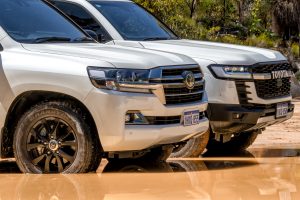
Yes, we were curious as well and decided that when push came to shove, the V8 had the jump off the mark; and that’s most likely down to the simple fact of increased capacity of 4.5 over 3.3L. But don’t despair. With shallower gearing in first and second, a broader range of ratios and quicker turbo response; the 300 bites hard as it chews down the air and fuel being forced into its cylinders. It quickly hauls in any lead the V8 200 may have had from boot down; and then begins to widen the gap.
Throughout our time in the GR Sport, the AJA0F 10-speed auto just got on with the job, without complaint or fuss. Changes were smooth, and it did a good job of grabbing the right gear for whatever demands we placed upon it. City, highway, bush or beach the auto works well with the V6’s power delivery, allowing you to put that flat wide torque curve to good use in overtaking manoeuvres, ploughing through soft sand or pointing skyward on larger dunes. And I didn’t experience any hunting during hill climbs like I had in a 200 Sahara Horizon a day or two earlier, when traveling the same road under similar driving conditions.
For every reason I liked to new 300 on the black top, I similarly appreciated its improvements off-road. With similar dimensions to the 200, ground clearance is up 10mm to 235mm with an approach and departure of 32 and 25 degrees on our test GR Sport. It has a wading depth is 700mm which is adequate if not best in class.
Having the opportunity to drive and watch both the 200 and 300 tackle the same range of conditions at the same time, it was evident that the capable 200 gave the impression it wanted to plough through challenges with force as opposed to overcoming them. It tortured the suspension and chassis with wheels at eye-watering angles up high into the guards. The opposing wheel pawed at the ground while the 200’s traction control worked hard to redirect engine torque to the opposing wheel forced deep into the wheel arch as the suspension system reached its limits of compression and extension.
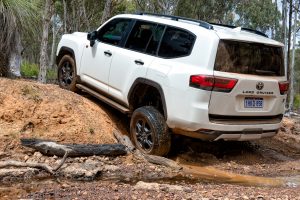
Whereas the 300, with its later version Electronic Kinetic Dynamic Suspension System and an additional 30mm of available flex, walked over deep moguls with much less strain on the traction control due to the wheels staying in contact with terra firma for longer. Our bush challenges saw the 300 successfully negotiate steep short ramps without stress. Even when the extended wheel was just skimming the gravel surface, the traction control intervened smoothly and effectively without the snatch and grab of lessor systems that could have seen the 300 slide sideways into a very precarious position. So determined was the 300 that we were forced to search for ever harder challenges to provide a reason to engage the diff locks. When we thought we’d got it beat, the diff locks made the near impossible task at hand a non-event.
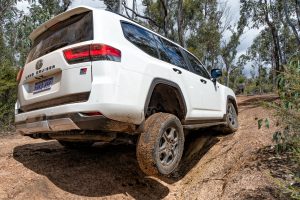
On the beach, after airing down the tyres, we cut our way through some soft sand with the new Cruiser providing a real sense of capability. There was loads of available torque on tap, even at lower rpm. The new V6 never felt strained and was always ready to pile on more torque if required.
This is where the lower ratio of first and second really came into play, allowing us to doddle around in high range. Only once did the Cruiser’s weight succumb to the talc powder white sand. Groaning at the thought of exercising digging techniques, we crossed our fingers and slipped the driveline into neutral. A flick of the toggle switch saw low range engage quickly, ready for action. The Multi Terrain Select (MTS) provides the usual options, plus an auto function that allows the vehicle to intelligently sense the terrain underfoot and adapt the traction control systems accordingly. We selected sand mode and, with gentle application of the throttle, moved back to help compress the powder beneath us, before moving forward with a relieved smile. The traction system provided more lateral control over wheel spin and a responsive throttle to drive forward using moderate momentum and that flat torque curve to get us out of trouble, sweat-free and relaxed.
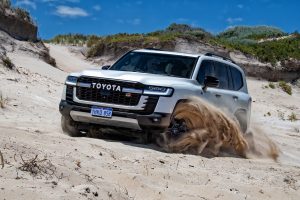
Conclusion:
Toyota may have been dragging their heels with only subtle tweaks to the venerable 200 over the past fourteen years. But is the new Landcruiser 300 just a minor evolution of the 200? Well, apart from its body shape and dimensions, it shares little else with its predecessor in terms of its overall engineering design and execution.
Most importantly, the 300 has retained the renowned positive attributes of what defines a Landcruiser, and it will certainly add to the legendary go anywhere do anything persona.
Toyota has reset the standards for capability, performance and luxury expected in an entirely new generation of this iconic nameplate. For the first time, Landcruiser has introduced sophistication and refinement commensurate with competitors in a global market—but done it without sacrificing core values. This is a vehicle fit for purpose straight from the showroom floor. It’s genuinely comfortable and robustly constructed to endure the demands of long-distance touring whilst offering uncompromising off-road capability.
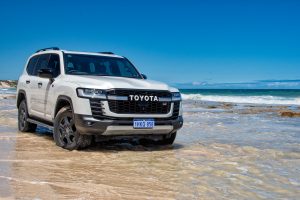
It’s hard to not be impressed with what Toyota has achieved. And it’s a relief to consider that the new vehicle isn’t an engineering gamble, but the culmination of some seven years of extensive testing and customer feedback on what real-world Landcruiser owners want and expect from their vehicles.
No, this is not a cheap vehicle. But you’d struggle to find another 4WDrive in the Australian market that delivers so much. It’s backed by a large Australia wide dealer support network; delivers both formidable off-road capability and notable on-road performance straight from the showroom floor; retains respectable resale value; has well-appointed occupant comfort while encasing everyone in the latest safety tech, and is all rolled into a practical and functional package that will happily motor across the two extremes of the pendulum to execute both city dwelling duties or adventurous Australian Outback travel.
But here’s where I’m debating Toyota’s logic.
Given the conditions that a vehicle will endure when outback touring, most people are likely to opt for a practical, simple yet robust base like the GX at $89,990 or maybe mid spec GXL to VX with their more appropriate interiors that will deal with the reality of dust, dirt, sand, wet clothes, and muddy shoes. In other words, a high proportion of buyers are those who are going to use their vehicles as intended and for what they are designed to do, get dirty and go off-road.
Entry price is more achievable, and you get a vehicle that’s relatively easy to customise to your requirements unencumbered by proprietary systems that may limit the options when setting up the vehicle for hard-core exploring, long distance touring or hauling the mobile home and toys around Australia.
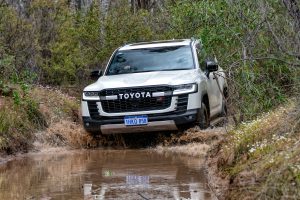
But why have Toyota chosen to fully off-road outfit only one vehicle in the range, the premium spec’d luxuriously appointed GR Sport, which is the second most expensive at a smidge under $138,000? They’ve thrown not some, but all of Toyota’s strongest off-road OEM arsenal at the GR Sport, combining front and rear locking diffs, Toyota’s clever proactive Electronic Kinetic Dynamic Suspension System, the Adaptive Variable Suspension and watchful Vehicle Dynamics Integration Management system.
All of which make it the most capable off-road variant in the range, but it’s packaged up with the luxury kit when there are not so insignificant savings to be had by opting out of all the nice to have opulent features and trimmings better suited to mall crawlers bound for the city lifestyle.
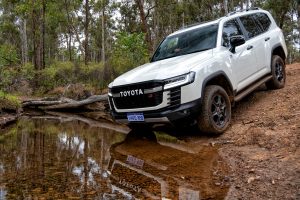
I can’t help but wonder if Toyota has a long game in play with another demographic in their cross hairs and are putting Europe’s finest on notice. If you can swallow the price, the GR Sport won’t leave you hungry for anything as it delivers on-road power, smooth handling, creature comfort, family practicality and excellent off-road capability.
Fast Facts:
Price: $137,790
Engine: 3.3 litre dual turbo diesel V6
Output: 227kW/700Nm
Transmission: Ten-speed automatic
Fuel: 8.9L/100
Safety rating ANCAP (Not yet tested at the time of writing this article)















